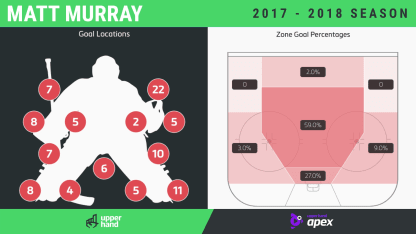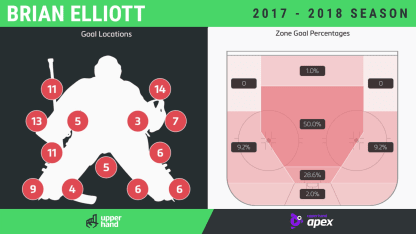High glove?:The spotlight of a run to the Stanley Cup Final illuminates the good and bad in any player's game. Winning back-to-back titles has allowed observers to focus on Murray's glove hand and identifying it as a possible weakness. Allowing 22 high-glove goals among his past 100 goals this season will do little to change the perception, even if his mid- and high-glove total of 27 percent is barely above the 24.6 percent average. Murray, though, is one of those rare goalies who moves better to his blocker side than to his glove, which can leave him late, off-angle and more stretched out on his glove side. He switched from more of a "handshake" to a "fingers-up" position with his glove in his second pro season to take away some of the space shooters see up high, but got caught dropping that glove early at times and with rebounds popping out of it at others.
Make him move:Side-to-side movement increases the chances of scoring on any goalie, and 70 percent of the 100 goals tracked on Murray involved some form of forced lateral movement, including 46 percent on plays that crossed the slot line, an imaginary line splitting the offensive zone from the goal line to the top of the faceoff circles. Although it isn't known how many of these chances Murray faced overall, it's a sign the Penguins gave up more high-quality chances this season than in the past.
Seven-hole seal:Murray's blocker position, with his right elbow sticking out to keep the stick blade on the ice, even in blocking situations, led to more goals under the arm and between the blocker and leg pad in the past but those numbers were each down this season.
Noticeable numbers:Murray's 19 against-the-grain goals, scored when the player or the puck was moving one way and pulled back to be shot in the other direction, included several that exploited a tendency to retreat straight back to his post, leaving him flat and off angle on the far side.




















